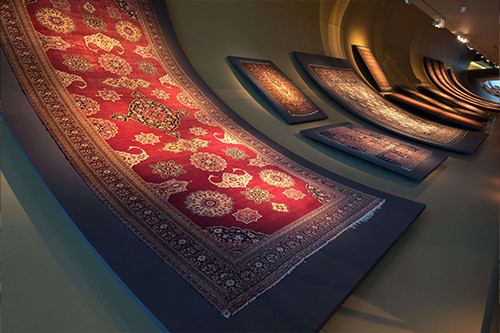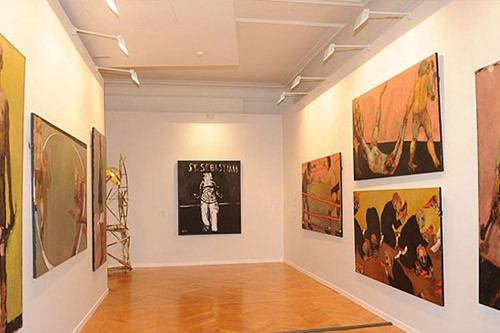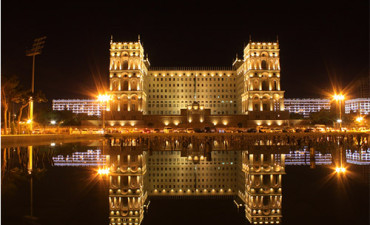Azerbaijani Carpets
From the ancient Silk Road to modern-day art galleries, Azerbaijani carpets have captivated the world with their intricate patterns, vibrant colors, and enduring craftsmanship. These exquisite textiles, woven with meticulous care and passed down through generations, embody the rich cultural heritage of Azerbaijan, a land steeped in artistry and tradition. The art of one's country is always considered the mirror to the very soul of this country and carpet weaving is no different, with the roots tracing back to the ancient times, it has been a beautiful and organic way of potraying the happiness, proudness and even grief of azerbaijani nation. The emotions splashing all over the carpets can be very self-explanotory and can be considered straight-forward, but there's a certain charm in honesty when it comes to art. That's why so many people are still heavely inspired and enthusiastic about azerbaijani carpets, even so many hundred years later, this charm drawing them in and opening a curtain of unknown.
In Azerbaijan, carpets held an integral role in daily life, serving as more than just decorative elements. They functioned as versatile pieces, providing comfortable spaces for relaxation, dining, and hosting guests. Almost every Azerbaijani household took pride in weaving their own carpets, reflecting a widespread tradition deeply embedded in the fabric of everyday existence. These intricately crafted carpets not only adorned living spaces but also played a crucial role in fostering a sense of cultural identity and familial heritage.

A Tapestry of History and Culture
The art of carpet weaving in Azerbaijan dates back thousands of years, with evidence of its practice found in archaeological excavations. Over time, carpet weaving became deeply ingrained in Azerbaijani culture, serving as a symbol of identity, wealth, and status. Nomadic tribes used carpets as portable shelters and decorative pieces, while in settled communities, carpets adorned homes and mosques, adding warmth, beauty, and spiritual significance.Azerbaijani carpets are renowned for their vibrant color palettes and intricate geometric patterns. The colors, often derived from natural dyes, carry symbolic meanings. Red represents life and energy, while blue symbolizes the sky and tranquility. Geometric motifs, such as stars, diamonds, and octagons, hold cultural significance, representing fertility, protection, and cosmic harmony.
The crafting of Azerbaijani carpets is a cherished tradition, handed down through generations from mother to daughter. It commences with the careful selection of premium wool or silk, followed by the manual spinning and dyeing of the fibers using natural pigments. The weaver then fastidiously ties the threads onto a loom, skillfully crafting the elaborate patterns that characterize Azerbaijani carpets. This process embodies a rich cultural legacy and exemplifies the dedication and artistry passed down within Azerbaijani families.
As previously mentioned, carpet weaving was a prevalent practice in nearly every household across Azerbaijan, spanning the entire territory of the region. Each distinct region contributed to this tradition with its unique style. Notable among these regional styles are:
• Guba: Renowned for their vibrant colors and bold geometric patterns, Guba carpets frequently showcase motifs inspired by animals and plants.
• Shirvan: Distinguished by their intricate designs and harmonious color schemes, Shirvan carpets often incorporate elaborate geometric patterns and stylized floral motifs.
• Karabakh: Celebrated for their deep red tones and elaborate geometric designs, Karabakh carpets frequently feature stylized depictions of animals and human figures, contributing to the rich tapestry of Azerbaijani carpet art.

If the family was expecting a child, there was a certain tradition of mother and other female relatives gathering together before the birth to indulge in weaving a carpet for a baby. This "baby carpet" was supposed to help a cradle move gently and prevent the child from hurting if they fell from the cradle. In certain regions different patterns on baby carpets were also supposed to give children defined traits like bravery, charm, intillegence and protect them from jinns (demons in Azerbaijan's folklore) growing up.
Love, too, found its voice in carpets. When a husband or lover went off to war, his wife or partner would pour her heart into weaving a rug that spoke of her devotion. It wasn't just a farewell gift; it was a piece of her soul, meant to be carried close or displayed proudly on his horse. These weren't mere decorative pieces; they were silent companions, woven with love and longing.
Though time has marched on and the industry has evolved, the sentiment remains. Twenty years ago, walls adorned with carpets were a badge of both wealth and wisdom. Even today, older generations treasure these woven tapestries, their rooms echoing with the whispers of stories they hold. Grandparents' houses become sanctuaries, steeped in tradition, where carpets are more than just decor; they're portals to the past.
And when loved ones pass, especially those who gave their lives as shehids (martyrs), their memory finds a special place above or on the carpet. It's a gesture of respect, a silent promise that their sacrifice is woven into the very fabric of the family.
Carpets in Azerbaijan are more than just threads and dyes; they're testaments to a culture's love, loss, and resilience. They're silent storytellers, whispering tales of mothers' hopes, lovers' fears, and ancestors' sacrifices. They're not just floor coverings; they're living tapestries, woven into the soul of Azerbaijan.

The National Azerbaijan Carpet Museum
In recognition of their cultural significance, the art of Azerbaijani carpet weaving was inscribed on the UNESCO Representative List of the Intangible Cultural Heritage of Humanity in 2010. Today, numerous initiatives, including museums, workshops, and educational programs, are dedicated to preserving and promoting this precious heritage.Azerbaijani carpets are more than just decorative textiles; they are tangible expressions of a rich cultural heritage, embodying centuries of artistry, tradition, and symbolism.
The National Azerbaijan Carpet Museum showcases the finest specimens and was established in 1967. In a recent development, the museum relocated to a new structure within the picturesque Primorsky Park, designed by Austrian architect Franz Jans to resemble an unfurling carpet. This architectural masterpiece, coupled with the museum's extensive and diverse collection, has made it a favorite destination for tourists.
Today, the museum boasts an impressive exhibition featuring over 15,000 items, including exquisite carpets, traditional costumes, ceramic household articles, and jewelry. The collection is continuously updated, with a particular focus on acquiring exceptional Azerbaijani carpets from the 17th to 18th centuries. Since 2016, following a presidential decree, the museum, under the guidance of director Shirin Melikova, actively seeks out these historical treasures worldwide, procuring them through auctions or private acquisitions.
To stand before an Azerbaijani carpet is to stand before a mirror reflecting the country's soul. Each intricate knot, each vibrant hue, whispers tales of resilience, of love, and of a people deeply intertwined with their land. It's a legacy woven not just with threads, but with the hopes, dreams, and tears of generations past.
So, dear reader, when you gaze upon these carpets, let them not be mere tapestries on a wall. Let them be portals to a world where the past dances with the present, where tradition whispers secrets to the modern ear. Let them ignite your curiosity, spark your imagination, and perhaps, inspire you to weave your own thread into the grand tapestry of Azerbaijan's soul.
If you're interested in seeing these wonders with your own eyes and hear the stories connecting you more deeply to the past and history behind each piece of art, Azerbaijan Travel International is there to help you ! We can arrange a tour, that is based entirely on your personal preferences.
Tags: Baku , Azerbaijan , Tradition , Quba region
Recent Posts

Buy any tour and get 15 percent discount in Baku restaurants

Festivals In Azerbaijan

Great Silk Road In Azerbaijan

Guide to outdoor activities






